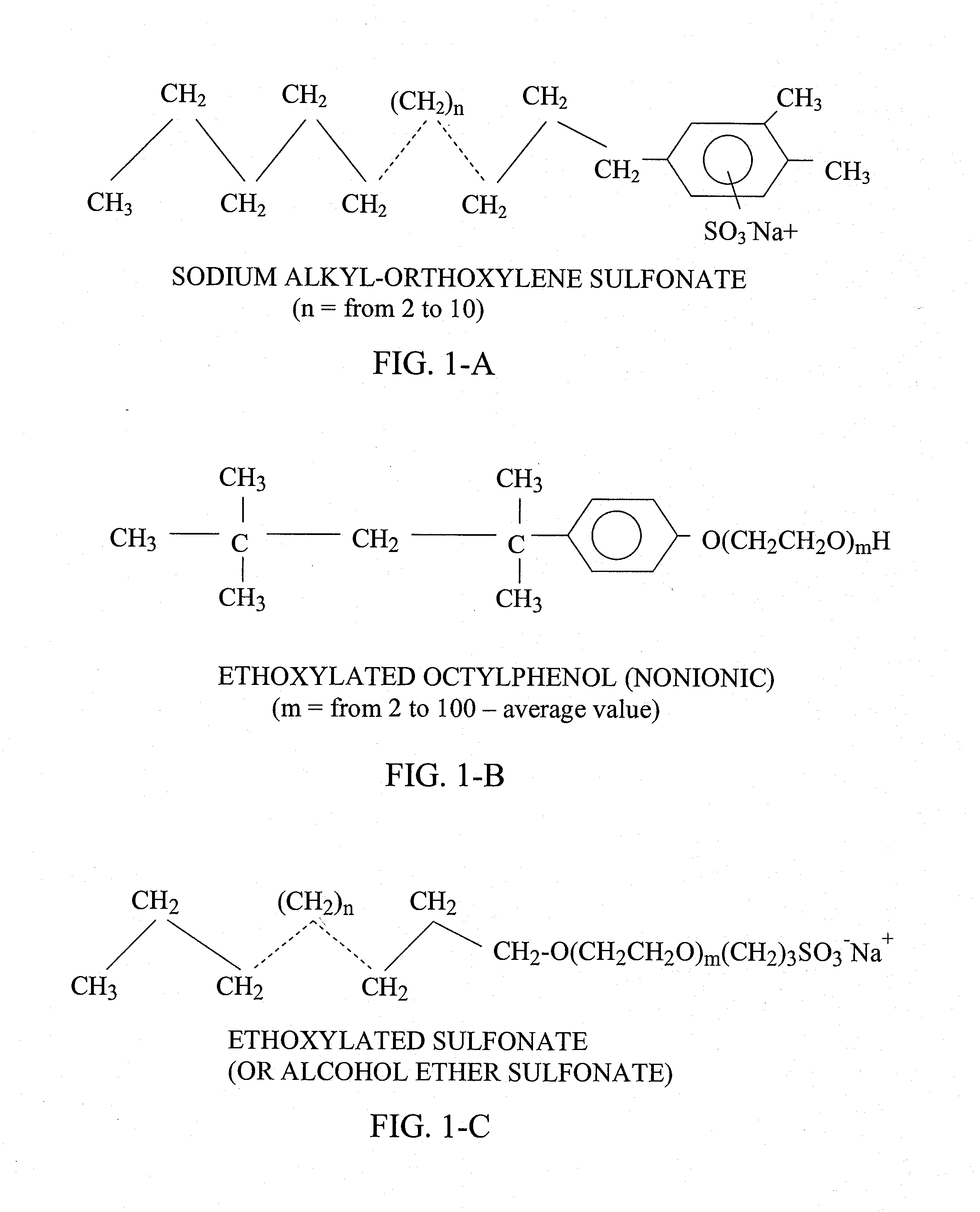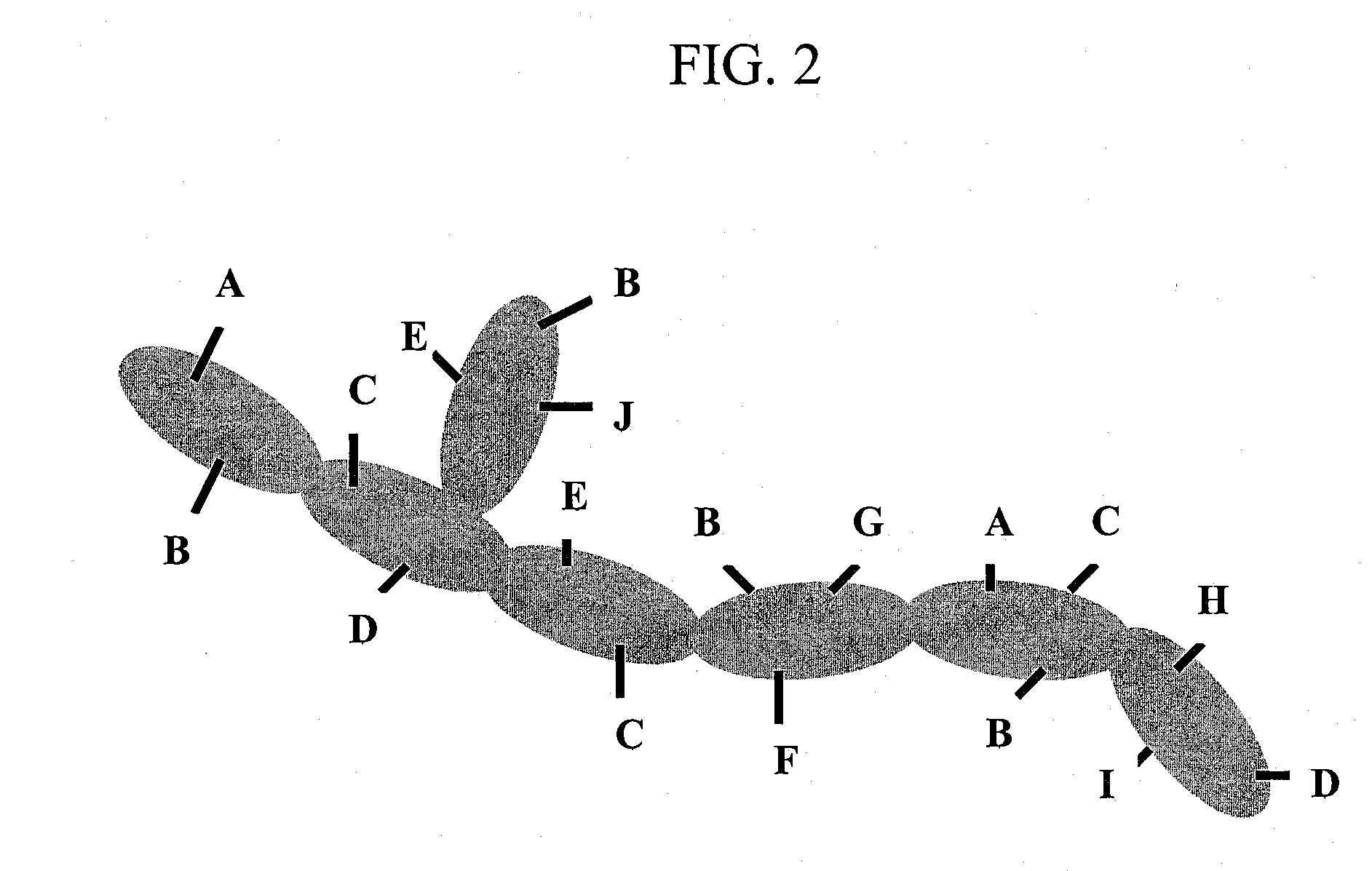Multifunctional multipolymeric surfactants for oil and bitumen recovery and other applications
a surfactant and multi-polymer technology, applied in the direction of drilling composition, chemistry apparatus and processes, other chemical processes, etc., can solve the problems of economic, environmental and material compatibility problems, polyacrylamides or xanthan gum is the added cost of oil recovery operation, and none of these applications includes the use of surfactants for oil displacement and recovery. , to achieve the effect of reducing the loss of volatile organic compounds
- Summary
- Abstract
- Description
- Claims
- Application Information
AI Technical Summary
Benefits of technology
Problems solved by technology
Method used
Image
Examples
example 1
Fractional Precipitation of Thickened B6-1 Surfactant
[0100]This example illustrates molecular differences between the B6-1 VA-t-AA and thickened B6-1, which is a combination of VA-t-AA and random VA-AA with relatively high VA content. This is shown clearly below:
Thickened B6-1=B6-1 VA-t-AA+Random VA-AA with relatively high VA content (8)[0101](˜75 wt %) (˜25 wt %)
From a performance standpoint, the additional 25 wt % of the random VA-AA copolymer can have dramatic effects compared to the base B61-VA-t-AA copolymer, as shown in Examples 3 and 4, below.
[0102]The fractional precipitation of the B6-1 thickened with the VA-AA copolymer provides a glimpse of the level of compatibility that can be achieved for the mixture. A 1-g quantity of the solid was dissolved in 100 g THF. The mixture was placed on a magnetic stirrer mixer and mixed with a stirrer bar. When the solid was completely dissolved, precipitant cyclohexane was added in drop by drop in roughly equal amounts in order to obtain...
example 2
Extraction of Heavy Crude Oil from Standard Sand
[0103]To demonstrate the capability of a multifunctional polymeric surfactant to remove heavy crude oil from sand, 1 part oil per 10 parts sand by weight was prepared. A particular type of sand (MI 2NS) was selected and dried by direct heat from a hot plate surface. The dried MI 2NS sand was passed through a 20-mesh screen for final sizing and air-tight storage. Before use, the stored sand was placed on a plastic pan up to ½-inch in height and re-dried using a microwave oven for about 2 minutes, with mechanical mixing every 30 seconds. A given weight of the microwaved sand was placed in a bottle along with the heavy crude oil (1 part by weight of heavy crude oil for 10 parts by weight of sand). The oil was distributed in the sand using a mechanical mixer for about 5 minutes at a mixing speed of about 100-500 rpm. Finally, the oil mixed with the sand was sealed in the bottle to be later used for extraction experiments.
[0104]Oil extracti...
example 3
Tar Sands Studies
[0109]Tar sand from the Ft. McMurray (Alberta, Canada) Duty Free Shop was used in the experiment. This sand contains a heavy type of bitumen, 15 wt % of which is dropped in the sand. Some 100-g quantities of the tar sand were placed in cylindrical glass bottles. Then, 100 g of either pure tap water or 0.5 wt % ammonia-neutralized B6-1 VA-t-AA copolymer in tap water was added in. The solid-fluid mixture of sand and aqueous fluid inside the bottles was conditioned at operating temperatures (60° C. or 80° C.) inside a Blue M natural convection oven for at least 1 hr. Each of the bottles was then opened and placed in a sand bath at the operating temperature. The sand was mixed using an electric wire beater mixer (lowest setting) for 5 or 15 minutes. The bitumen that floated to the top of the aqueous layer was harvested using a pre-weighed soie brush, and excess bitumen was placed in a pre-weighed cup. Results of the experiment are shown in Table 3 below.
[0110]Table 3. R...
PUM
| Property | Measurement | Unit |
|---|---|---|
| Pressure | aaaaa | aaaaa |
| Mass | aaaaa | aaaaa |
| Electric dipole moment | aaaaa | aaaaa |
Abstract
Description
Claims
Application Information
 Login to View More
Login to View More - R&D
- Intellectual Property
- Life Sciences
- Materials
- Tech Scout
- Unparalleled Data Quality
- Higher Quality Content
- 60% Fewer Hallucinations
Browse by: Latest US Patents, China's latest patents, Technical Efficacy Thesaurus, Application Domain, Technology Topic, Popular Technical Reports.
© 2025 PatSnap. All rights reserved.Legal|Privacy policy|Modern Slavery Act Transparency Statement|Sitemap|About US| Contact US: help@patsnap.com



